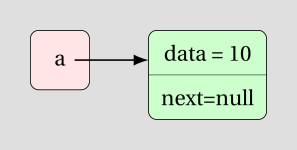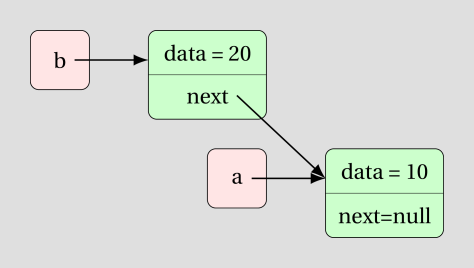Recursive data structures
Assumed Knowledge
Learning Outcomes
- Be able to create and operate on a class holding one or more references of the same type
Author: Gaurav Gupta
Pre-requisite knowledge
Make sure you read the lecture notes on class composition before you begin studying these notes.
The Node class
Consider the following class:
1
2
3
4
5
6
7
8
9
public class Node {
public int data;
public Node next;
public Node(int d, Node n) {
data = d;
next = n;
}
}
Every Node object holds a reference to another Node object.
Here, we created an anonymous Node object - new Node(10, null) - and passed it as a parameter to the constructor of head.
Linking nodes
We can link any number of nodes as we want.
1
2
3
4
5
Node n5 = new Node(20, null);
Node n4 = new Node(70, n5);
Node n3 = new Node(10, n4);
Node n2 = new Node(90, n3);
Node n1 = new Node(30, n2);
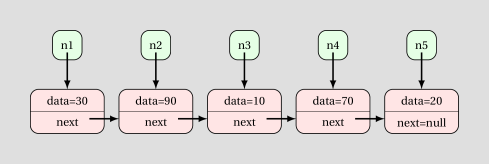
Simplified representation:

We can get all the values using the “first” node, in this case, n1 :)
1
2
3
4
5
System.out.println(n1.data); //30
System.out.println(n1.next.data); //90
System.out.println(n1.next.next.data); //10
System.out.println(n1.next.next.next.data); //70
System.out.println(n1.next.next.next.next.data); //20
One useful thing to remember (in this example), is that any time you access the next attribute or instance variable on an object, it refers to the next object in line. If you access the data attribute or instance variable, that gives you the information stored in that particular node.
If we create a Node reference temp initialized to n1, we can re-reference it to the Node after it using temp = temp.next. Thereby, repeating the operation over and over.
1
2
3
4
5
6
Node temp = n1; //temp refers to same instance as n1
temp = temp.next; //temp refers to node after temp or n1 which is n2
temp = temp.next; //temp refers to node after temp or n2 which is n3
temp = temp.next; //temp refers to n4
temp = temp.next; //temp refers to n5
temp = temp.next; //temp is now null - STOP
Abstracting into a loop to add all the values:
1
2
3
4
5
6
Node temp = n1;
int total = 0;
while(temp != null) {
total = total + temp.data;
temp = temp.next;
}
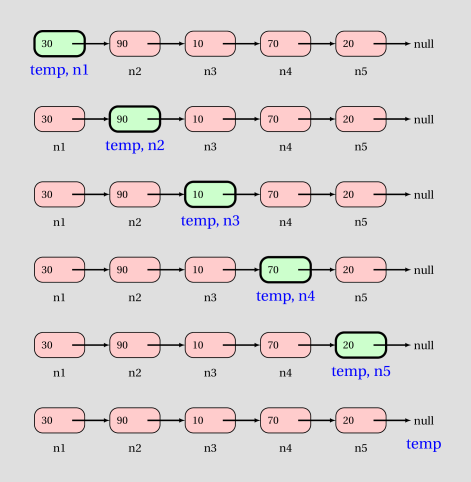
Careful to not lose the reference to the starting node
What would happen if we write the following code?
1
2
3
4
5
int total = 0;
while(n1 != null) {
total = total + n1.data;
n1 = n1.next;
}
total will hold the correct value but n1 now becomes null.
Once, instances don’t have any incoming references, they are deleted by Java.
So, if you try to do anything using n1 again, well … good luck!
Hence, we should always make a reference copy of the starting node before operating on it.
Some examples of traversing a recursive data structure
We will assume the reference to the first node in the chain is in head.
1. Count the number of items in the list
1
2
3
4
5
6
Node temp = head;
int count = 0;
while(temp != null) {
count++;
temp = temp.next;
}
2. Add up all odd numbers in the list
1
2
3
4
5
6
7
8
Node temp = head;
int countOdds = 0;
while(temp != null) {
if(temp.data%2 != 0) {
countOdds++;
}
temp = temp.next;
}
We can also use a for-loop to do the same:
1
2
3
4
5
6
int countOdds = 0;
for(Node temp = head; temp != null; temp = temp.next) {
if(temp.data%2 != 0) {
countOdds++;
}
}
3. Checking if all items in the list are positive
1
2
3
4
5
6
boolean allPositives = true;
for(Node temp = head; temp != null && allPositives; temp = temp.next) {
if(temp.data%2 <= 0) { //any violation?
allPositives = false;
}
}
Note how we updated the loop expression to temp != null && allPositives so as soon as the first non-positive item is found, we can exit the loop (without break, because … Ew!)
4. Remove the last item in the list
1
2
3
4
5
6
7
8
9
10
11
12
13
if(head != null) { //there is at least one node in the list
if(head.next == null) { //there is only one node in the list
head = head.next;
}
else { //there are at least two nodes in the list
Node temp = head;
while(temp!=null && temp.next!=null) {
temp = temp.next;
}
//temp is guaranteed to be hold a reference to the SECOND-LAST node in the list
temp.next = null; //de-reference temp.next so it doesn't refer to currently last node
}
}
5. Remove the first zero in the list, if any,
1
2
3
4
5
6
7
8
9
10
11
12
13
14
if(head!=null) {
if(head.data == 0) {
head = head.next;
}
else {
boolean found = false;
for(Node temp = head; temp.next!=null && !found; temp = temp.next) {
if(temp.next.data == 0) {
temp.next = temp.next.next; //make temp.next refer to the node after the next node
found = true;
}
}
}
}
6. Removing ALL even numbers from the list
1
2
3
4
5
6
7
8
9
10
11
12
13
14
//first remove all even nodes at the front
while(head!=null && head.data%2 == 0) {
head = head.next;
}
//now remove all even nodes AFTER head, if any
Node cur = head;
while(cur != null) { //cur, if not null, definitely contains an odd number
if(cur.next.data%2 == 0) {
cur.next = cur.next.next;
}
else {
cur = cur.next;
}
}
Passing a node to a function
Thankfully, that is exactly how objects are passed to functions - as reference copies of the actual parameter.
So, if I had a function:
1
2
3
4
5
6
7
8
public static int sum(Node start) {
int total = 0;
while(start != null) {
total = total + start.data;
start = start.next;
}
return total;
}
I can call it as sum(n1), thereby start being a reference copy of n1 and updated. But not n1. Life is good again :)
Recursion is a beautiful thing
To calculate the sum of all nodes starting at a node start,
- if
startisnull, you can return 0, - otherwise, you can add
start.datato the sum of all nodes starting atstart.next.
1
2
3
4
5
6
7
8
public static int sum(Node start) {
if(start == null) {
return 0;
}
else {
return start.data + sum(start.next);
}
}
YESSS!!!
Keep moving
What is the bug in the following code?
1
2
3
4
5
6
7
8
9
10
public static int sumPositives(Node start) {
int total = 0;
while(start != null) {
if(start.data > 0) {
total = total + start.data;
start = start.next;
}
}
return total;
}
We only move to the next node if the value in the current one is greater than 0.
The movement forward (start = start.next), just like the classic i++, is almost always unconditional.
Correct code:
1
2
3
4
5
6
7
8
9
10
public static int sumPositives(Node start) {
int total = 0;
while(start != null) {
if(start.data > 0) {
total = total + start.data;
}
start = start.next;
}
return total;
}
Some people prefer a for-loop for this very reason:
1
2
3
4
5
6
7
8
9
public static int sumPositives(Node start) {
int total = 0;
for(; start != null; start = start.next) {
if(start.data > 0) {
total = total + start.data;
}
}
return total;
}
Recursive version:
1
2
3
4
5
6
7
8
9
10
11
public static int sumPositives(Node start) {
if(start == null) {
return 0;
}
if(start.data > 0) {
return start.data + sumPositives(start.next);
}
else {
return sumPositives(start.next);
}
}
If, for any reason, you need to hold on to the original reference of start, you can always copy into another variable as,
1
2
3
4
5
6
7
8
9
10
11
12
//this is the classic handshake algorithm
public static boolean allUnique(Node start) {
for(Node nodeA = start; nodeA != null; nodeA = nodeA.next) { //for all nodes
//check against all other nodes AFTER it
for(Node nodeB = nodeA.next; nodeB != null; nodeB = nodeB.next) {
if(nodeA.data == nodeB.data) {
return false;
}
}
}
return true;
}
Recursive version:
1
2
3
4
5
6
7
8
9
10
11
12
13
public static boolean allUnique(Node start) {
if(start == null) {
return true; //vacuous truth
}
return !contains(start.next, start.data) && allUnique(start.next);
}
public static boolean contains(Node start, int target) {
if(start == null) {
return false;
}
return start.data == target || contains(start.next, target);
}
You should be careful about your loop expression
Consider an example where you want to check if a list contains the same item twice in a row (at reference x as well as x.next). Note: I am modifying the reference start here. This does not modify the actual parameter in the client.
1
2
3
4
5
6
7
8
9
10
//BUGGY!!!
public static boolean twoInARow(Node start) {
while(start != null) { //BUG!
if(start.data == start.next.data) {
return true;
}
start = start.next;
}
return false;
}
We are checking for the data value inside start as well as start.next but we have only ensured that start is not null. We need to check that start.next is not null either.
If we simply check while(start.next != null), that would cause a problem if start itself is null. Hence, the loop expression should be while(start != null && start.next != null).
1
2
3
4
5
6
7
8
9
10
//CORRECT
public static boolean twoInARow(Node start) {
while(start != null && start.next != null) {
if(start.data == start.next.data) {
return true;
}
start = start.next;
}
return false;
}
Recursive version:
1
2
3
4
5
6
7
8
9
public static boolean twoInARow(Node start) {
if (start == null || start.next == null) {
return false;
}
if(start.data == start.next.data) {
return true;
}
return twoInARow(start.next);
}
Nodes can hold other objects too
In the previous example, we saw a node holding integer data, but it can hold any kind of data. For starters, take a look at RNode holding Rectangle object.
For the classes defined in,
Consider the following code,
1
2
3
4
Rectangle r1 = new Rectangle(2.5, 1.5);
Rectangle r2 = new Rectangle(4.2, 3.6);
RNode q = new RNode(r2, null);
RNode p = new RNode(r1, q);
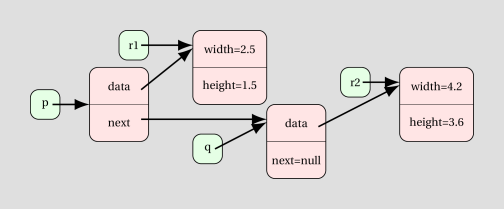
We can create anonymous objects to reduce variable count.
1
2
RNode q = new RNode(new Rectangle(4.2, 3.6), null);
RNode p = new RNode(new Rectangle(2.5, 1.5), q);
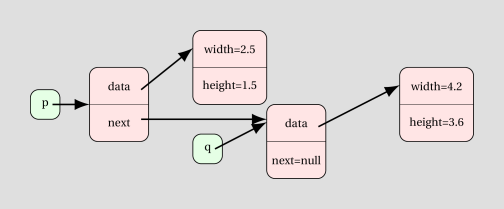
Be careful while comparing objects!!!
Consider the following function that attempts to check if a specific rectangle exists in a list or not:
1
2
3
4
5
6
7
8
public static boolean contains(RNode start, Rectangle target) {
for(Node current = start; current != null; current = current.next) {
if(current.data == target) {
return true;
}
}
return false;
}
Here, the current.data == target checks if the two are reference copies!
The right version is:
1
2
3
4
5
6
7
8
public static boolean contains(RNode start, Rectangle target) {
for(Node current = start; current != null; current = current.next) {
if(current.data.equals(target)) {
return true;
}
}
return false;
}
Here, the current.data.equals(target) checks for equality based on the definition of what “equal” is (defined in class Rectangle).
Recursive version:
1
2
3
4
5
6
7
8
public static boolean contains(RNode start, Rectangle target) {
if(start == null) {
return false;
}
else {
return start.data.equals(target) || contains(start.next, target);
}
}
With a little help from my friends
Anything you can do with loops, you can do recursively… sometimes, with the use of helper functions.
For example, a function that reverses a list and returns the reference to the starting Node, such that if n -> 10 -> 70 -> 20 -> 90 -> null, it returns a reference to a Node (say, k) such that k -> 90 -> 20 -> 70 -> 10 -> null.
1
2
3
4
5
6
7
8
public static Node reversed(Node n) {
Node temp = null;
while(n != null) {
temp = new Node(n.data, temp);
n = n.next;
}
return temp;
}
The above version is called out-of-place algorithm and will create a second list of the same size as the original list, which can be pretty costly. A recursive out-of-place version is provided below.
Thanks to Xingyu (Ara) Cai for providing the following three elegant solutions! Well done, Ara :)

1
2
3
4
5
6
7
8
9
10
11
public static Node reverseOutPlaceRecursive(Node start) {
return reverseOutPlaceRecursive(start, null);
}
public static Node reverseOutPlaceRecursive(Node start, Node previous){
if (start == null) {
return previous;
}
previous = new Node(start.data, previous);
return reverseOutPlaceRecursive(start.next, previous);
}
Instead, an in-place algorithm (HD example) modifies the existing list, so no new instances are created. Here’s an in-place version (Note: reverse vs. reversed):
1
2
3
4
5
6
7
8
9
public static void reverseInPlace(Node start){
Node previous = null;
while (start != null) {
Node next = start.next;
start.next = previous;
previous = start;
start = next;
}
}
A completely recursive in-place version is:
1
2
3
4
5
6
7
8
9
10
11
public static void reverseInPlaceRecursive(Node start) {
return reverseInPlaceRecursive(start, null);
}
public static void reverseInPlaceRecursive(Node start, Node previous){
if (start != null) {
Node next = start.next;
start.next = previous;
reverseInPlaceRecursive(next, start);
}
}
Activities
Task 1
For the class Node, draw the memory diagram to illustrate objects after the last statement of the following code executes.
1
2
3
4
Node a = new Node(20, null);
Node b = new Node(70, a);
Node c = new Node(10, a);
Node d = new Node(90, c);
Task 2
For the class Node, draw the memory diagram to illustrate objects after the last statement of the following code executes.
1
2
3
4
5
Node a = new Node(20, null);
Node b = new Node(70, a);
Node c = new Node(10, b);
Node d = new Node(90, c);
a.next = d;
Task 3
For the class Node, draw the memory diagram to illustrate objects after the last statement of the following code executes.
1
2
3
4
5
Node a = new Node(20, null);
Node b = new Node(70, a);
Node c = new Node(10, b);
Node d = new Node(90, c);
a.next = d.next;
Task 4
For the class Node, draw the memory diagram to illustrate objects after the last statement of the following code executes.
1
2
3
4
5
Node a = new Node(20, null);
Node b = new Node(70, a);
Node c = new Node(10, b);
Node d = new Node(90, c);
a.next = d.next.next;
Task 5
For the class Node, the following code attempts to store the sum of all items in the chain of nodes into a variable total. However, it has a bug. Briefly explain what is the problem with the code, and correct it.
1
2
3
4
5
6
7
8
9
10
Node a = new Node(20, null);
Node b = new Node(70, a);
Node c = new Node(10, b);
Node d = new Node(90, c);
int total = 0;
Node current = d;
while(current != null) {
total = total + current;
current = current.next;
}
Task 6
For the class Node, the following code attempts to store the number of nodes in the chain into a variable size. However, it has a bug. Briefly explain what is the problem with the code, and correct it.
1
2
3
4
5
6
7
8
9
Node a = new Node(20, null);
Node b = new Node(70, a);
Node c = new Node(10, b);
Node d = new Node(90, c);
int size = 0;
Node current = d;
while(current != null) {
size = size + 1;
}
Task 7
For the class Node, what is the value of result after the following code is executed?
1
2
3
4
5
6
7
8
9
10
11
12
13
14
15
Node a = new Node(20, null);
Node b = new Node(70, a);
Node c = new Node(10, b);
Node d = new Node(90, c);
int result = 0;
Node current = d;
while(current != null) {
if(current.data >= 20) {
result = result * 10 + 1;
}
else {
result = result * 10;
}
current = current.next;
}
Task 8
For the class Node, what is the value of result after the following code executes?
1
2
3
4
5
6
7
8
9
Node a = new Node(9, null);
Node b = new Node(2, a);
Node c = new Node(7, b);
Node d = new Node(1, c);
a.next = d;
a.data = 1000*d.data +
100*d.next.data +
10*d.next.next.data +
1*d.next.next.next.data;
Task 9
Consider the following class definition for TreeNode:
1
2
3
4
5
6
7
8
9
public class TreeNode {
public int data;
public TreeNode left, right;
public TreeNode(int d, TreeNode l, TreeNode r) {
data = d;
left = l;
right = r;
}
}
Draw the memory diagram to illustrate objects after the last statement of the following code executes. Also, state the number of instances and references in the diagram.
1
2
3
TreeNode t1 = new TreeNode(20, null, null);
TreeNode t2 = new TreeNode(-10, null, null);
TreeNode t3 = new TreeNode(70, t1, t2);
Task 10
Complete the following function that when passed the starting Node of a list of Node objects, returns the sum of all even numbers in the list.
1
2
3
public static int sumEvens(Node start) {
//to be completed
}
Task 11
Complete the following function that when passed the starting Node of a list of Node objects, returns true if all items in the list are in the range [0, 100].
1
2
3
public static boolean allMarksValid(Node start) {
//to be completed
}
Task 12
Complete the following function that when passed the starting Node of a list of Node objects, returns the number of items that are greater than the first item.
1
2
3
public static int countGreaterThanFirst(Node start) {
//to be completed
}
Task 13
Complete the following function that when passed the starting Node of a list of Node objects, returns a reference to the first Node that holds a positive value, null if none of the nodes do.
1
2
3
public static Node firstPositive(Node start) {
//to be completed
}
Task 14
Complete the following function that when passed the starting Node of a list of Node objects, returns a reference to the last Node that holds a positive value, null if none of the nodes do.
1
2
3
public static Node lastPositive(Node start) {
//to be completed
}
Task 15
Complete the following function that when passed the starting Node of a list of Node objects, returns true if it is in ascending order, false otherwise.
1
2
3
public static boolean isAscending(Node start) {
//to be completed
}
Task 16
Complete the following function that when passed the starting Node of a list of Node objects, returns true if it contains three of the same values next to each other, false otherwise.
1
2
3
public static boolean threeInARow(Node start) {
//to be completed
}
Task 17
Define a function named identical that when passed the starting Nodes of two lists of Node objects, returns true if they are identical, and false otherwise.
Task 18
Define a function named removeNegatives that when passed the starting Node of a list of Node objects, remove all negative nodes from the list.
Task 19
Define a function named merge that when passed the starting Nodes of two lists of Node objects, returns the starting Node of the two merged together such that all items of the first list are in the resulting list before all the items of the second list (and in the original order). Neither of the original lists should be modified.
Task 20
Define a function named longestAscendingSequence that when passed the starting Node of a list of Node objects, returns the reference of the Node that begins the longest ascending sequence within the original list. Return the Node that occurs first in case of a tie. The original list should not be modified.
Task 21
Define Date, Time, and DateTime classes (think about what they will contain), and create a class NodeDateTime that holds one DateTime object and one NodeDateTime object.
Define a function that when passed the starting node of a list of NodeDateTime objects and an integer (say, n), returns true if the list contains at least n identical objects.
